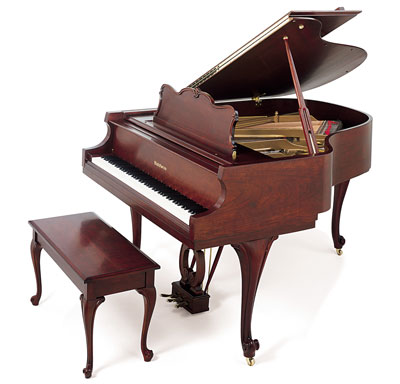 In 1862, reed organ and violin teacher Dwight Hamilton Baldwin opened the doors to his music store in Cincinnati, Ohio. During the next quarter century, Baldwin became one of the largest piano retailers in the Midwestern United States.
In 1862, reed organ and violin teacher Dwight Hamilton Baldwin opened the doors to his music store in Cincinnati, Ohio. During the next quarter century, Baldwin became one of the largest piano retailers in the Midwestern United States.
The first Baldwin piano, an upright model, was available in 1891. In 1895, the company introduced its first grand piano, a 5'4" model.
On August 23, 1899, D.H. Baldwin died. Fortunately, one of his strengths had been hiring young men with the potential to lead his company. Lucien Wulsin, who was raised in Alexandria, Kentucky, displayed such promise.
In 1866, Wulsin was a bookeeper for Baldwin. Within seven years, he had become a partner. With a devotion to both business and art, Wulsin helped Baldwin evolve from a successful retail enterprise to a leading builder of pianos.
Baldwin established a worldwide reputation by winning top awards at key expositions. A Baldwin concert grand was honored with the Grand Prix Award at the 1900 International Exhibition in Paris, the first American-made piano to earn the award. It then took top honors in St. Louis (1904) and at London's Anglo-American Exposition in 1914.
By 1913, Baldwin enjoyed a robust international business, exporting pianos to 32 countries around the globe. Three years later, the company boasted retail divisions in Cincinnati, Chicago, Dallas, Denver, Indianapolis, Louisville, New York, St. Louis and San Francisco.
In addition to traditional pianos, Baldwin manufactured a variety of player piano models, available in both grand and upright styles. This market segement grew quickly, peaking at 56 percent of the industry's total piano production in 1923. Unfortunately, due to new forms of entertainment including the radio, movies, phonographs and automobiles, player sales fell 86 percent by 1929.
Compounding the loss, the Great Depression began in 1929. Baldwin's survival was due to its prudent management. During the early 1920s, Baldwin had created large special reserves for unforeseen needs. These financial resources, along with the direction of Lucien Wulsin II, enabled the company to weather the adversity of this period.
By 1936 the piano industry had rebounded, as consumer purchases in general had risen. The National Piano Manufacturers Association reported that piano sales during the first six months of 1936 were the highest in 15 years.
Baldwin business was interrupted in 1942 when the U.S. War Production Board ordered all piano building stopped due to the war effort. Because of its woodworking expertise, Baldwin manufactured wings, fuselage parts and center sections for the Aeronca PT-23 training plane and the Curtiss-Wright C-76 cargo plane, as well as parts for fighter, bomber and glider aircraft.
Lessons learned in the construction of multiple-ply aircraft wings became the basis for Baldwin's 41-ply maple piano pinblock, still in use today for its exceptional tuning stability and strength.
Piano production began soon after the war ended in 1945. A strong post-war economy boosted sales, with Baldwin's 1953 piano production doubling that of its pre-war peak.
In 1965, a revolutionary new Baldwin was introduced. The SD10 Concert Grand was heralded as a major advancement in piano design. A music critic cited in a Time magazine article about the new piano exclaimed, "If Beethoven had had a piano like that, the course of music would have been radically altered."
Today, Baldwin enters the new millennium under the leadership of Gibson Guitar Corp. with headquarters in Nashville, Tennessee. Baldwin continues to offer acoustic pianos bearing the Baldwin, Chickering and Wurlitzer brand names. Cutting-edge Baldwin Pianovelle digital instruments complete the company's offerings. Consumers can choose from a wide variety of acoustic and digital pianos in both upright and grand cabinets.
For more information visit: http://www.baldwinpiano.com


 In 1862, reed organ and violin teacher Dwight Hamilton Baldwin opened the doors to his music store in Cincinnati, Ohio. During the next quarter century, Baldwin became one of the largest piano retailers in the Midwestern United States.
In 1862, reed organ and violin teacher Dwight Hamilton Baldwin opened the doors to his music store in Cincinnati, Ohio. During the next quarter century, Baldwin became one of the largest piano retailers in the Midwestern United States.